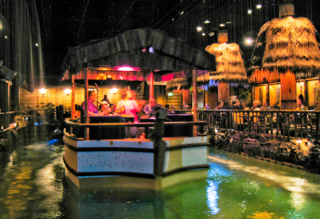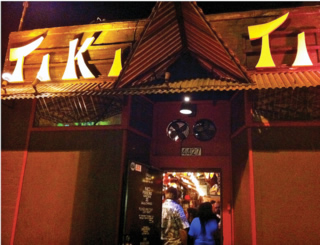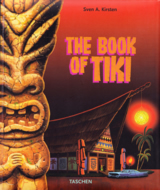Paradise Found - Page 2
 |
1. Take in a can't-miss tiki bar up north
The first stop on any foray into tiki culture should be at one of the state's classic tiki bars. It's the best way to fully immerse one's self into the culture without a time or monetary commitment beyond buying a drink. Though many tiki palaces of yore have been lost to the ages, a few remain, like time capsules preserving a lost age.
In Northern California, our experts agreed the Tonga Room, open since 1945, is a can't-miss destination, even though, as Kirsten points out, "they went full Polynesian relatively late, in the '70s."
But this former swimming pool space beneath the Fairmont Hotel encapsulates so much of classic tiki that it still serves as one of the best examples going.
The pool now serves as a massive water feature on which a bandstand floats. Sprinklers in the ceiling spring forth with a tropical 'rain storm' every 20 minutes, complete with thunder and lightning effects.
"Tonga has all the elements of tiki," Von Stroheim says. "It has hanging lamps, it has little private areas, it's sectioned off. You have the boathouse area off to the left, you have the dance floor that is like a ship's top deck and prow, and then on the other side you have individual huts."
Across the bay, in Emeryville, the historic Trader Vic's topped Martin Cate's list. "It's a beautiful setting out on the water," he says, "and it's great to see all the old art and collectibles and antiquities from the old Oakland location there."
Cate's own bar, Smuggler's Cove, should also join any tiki itinerary. Amid its elaborate nautical dècor and indoor waterfall, Cate has accumulated more than 400 varieties of rum and instituted a tasting program called the Rumbustion Society. Members taste their way through the menu and achieve ranks when they hit milestones of 100 varieties.
The extensive cocktail menu takes a historical approach to rum drinks. There's a section for drinks from famous tiki bars, one for traditional Caribbean cocktails, some 'classic libations of prohibition-era Havana,' and so on.
• The Tonga Room and Hurricane Bar (950 Mason St., San Francisco): tongaroom.com
• Trader Vic's (9 Anchor Dr., Emeryville): tradervicsemeryville.com
• Smuggler's Cove (650 Gough St., San Francisco): smugglerscovesf.com
 |
2. Fill up at a tiki classic down south
In Southern California, the Tiki Ti is arguably the most historic remaining example of the classic mid-century tiki bar. It's small, but immaculately decorated, tracing its lineage directly to the old Don the Beachcomber, the original tiki bar. Tiki Ti founder Ray Buen started at Don's in 1934, the same year Ernest Ray Gantt founded it.
Buen opened Tiki Ti in 1961, with a menu of original drinks derived from Gantt. His children took it over in the '70s and their children in the '90s, passing the drink recipes down through the generations. "There's nothing else like it," Cate says. "It feels like history."
In 2009, a new Don the Beachcomber opened in Huntington Beach (now closed unfortunately), in the location of the longtime classic Sam's Seafood. It's not exactly the same, but as Kirsten points out, there's a tiki pedigree to the space, where in the '60s Sam's had installed a Polynesian-style A-frame entrance and a 'hidden village' in back.
History buffs might also want to make a stop by the Tonga Hut in North Hollywood, which opened in 1959 and is oldest continuously operating tiki bar in Los Angeles.
• Tiki Ti (4427 Sunset Blvd., Los Angeles): tiki-ti.com
• Tonga Hut (12808 Victory Blvd., North Hollywood): tongahut.com
 |
3. Dip into a tome that defines the tiki genre
Tiki bars will almost certainly whet the appetite for more information about the subculture's history, especially as so much of it has been lost. So a few good books ought to be next on the list.
"The ultimate choice is The Book of Tiki, by Sven," says Von Stroheim. This is the book that helped define tiki as a classic part of Americana; and it, along with Kirsten's follow-up tome, Tiki Modern, was among the first to lay out the history and evolution of the movement.
"I don't want to exaggerate my contribution, but in its own day nobody had classified tiki and defined it the way I did in my books," Kirsten says.
"Tiki existed in isolated places—every city in the U.S. had a tiki bar, and people all over the country had their own tiki rumpus rooms. The West Coast and East Coast had their own tiki apartment buildings and motels.
"But nobody put all the different aspects of it to define it as a style. By me collecting all that material and putting the ducks in a row, so to speak, I hope I helped define it as a genre in its own right."
Where Kirsten catalogued tiki as an aesthetic subculture, Jeff 'Beach Bum' Berry worked to document the food and drink of the movement. Von Stroheim and Cate both recommend Beachbum Berry's Sippin Safari.
"It's a combination of good cocktail information, but also a narrative of the lives of these old bartenders," Cate says. As a cocktail guide, Cate also recommends Beach Bum Berry Remixed, which came after his first few booze books, Intoxica!, Grog Log, and Taboo Table. "It updates the recipes for mistakes or bad information, and includes new recipes from contemporary bartenders."
• The Book of Tiki - Sven Kirsten (Taschen)
• Tiki Modern - Sven Kirsten (Taschen)
• Beachbum Berry's Sippin' Safari and Beach Bum Berry Remixed - Jeff Berry (SLG Publishing)




